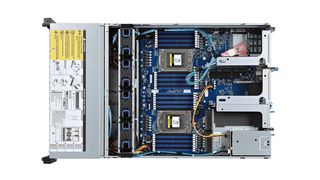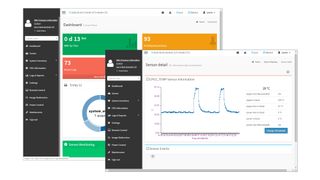IT Pro Verdict
Pros
- +
Good value
- +
High performance EPYC CPUs
- +
Clean internal design
- +
Big expansion potential
- +
Extensive storage options
Cons
- -
Limited remote management features
AMD put Intel under tremendous pressure when it launched its EPYC Gen2 core-heavy server CPUs, and it now turns the screws with the release of three high-frequency models. The EPYC 7Fx2 family directly targets enterprise workloads, with HPC and relational database applications high on their hit list. AMD also aims to hurt Intel on price and performance.
Showcasing these new CPUs, Broadberry’s CyberServe R282-Z91 was supplied to us with dual 3.5GHz 16-core EPYC 7F52 modules. Pitched by AMD against Intel’s Xeon Scalable Gold 6246R and 6242, the EPYC 7F52 looks capable of giving them a good shoeing, with a higher base frequency, a much larger cache per core, support for faster 3,200MHz DDR4 memory and 2TB per socket, not to mention 8 memory channels and 128 lanes of PCI-E 4.0.
Built around Gigabyte’s R282-Z91 2U bare-bones rack server, the CyberStore is geared up for storage capacity as well as processing performance. It’s no surprise Broadberry partners with Gigabyte, as this manufacturer now offers 30 EPYC 7002 rack server solutions – more than the rest put together.
Broadberry CyberServe R282-Z91 review: Internal design
The EPYC 7F52 CPUs have high 240W TDPs so cooling needs to be good. Internally, the server has a clean, open design with plenty of room for front-to-back air flow allowing Gigabyte to employ its standard array of four hot-swap fan modules arranged in front of the motherboard.
The CPUs have large passive heatsinks and we found this partnership worked well, with their temperatures settling at around 30°C in idle and peaking at 60°C with all cores under prolonged maximum load. A downside is the fan default speed is 6,300rpm, so noise is high and even with the system in idle, we measured sound levels of 68.5dB from one metre in front of the server.
The motherboard offers an embedded M.2 NVMe SSD slot but if you populate it, the extra heat it generates will limit CPUs to 225W TDP. There are no other restrictions though, so you can make full use of the server’s high expansion potential.

The server provides three risers with a total of eight PCI-E 4.0 slots and there’s room for six full-height, half-length and two half-height adapter cards. These high-bandwidth slots add extra versatility as they can support 50GbE and 100GbE network adapters.
The server also has OCP (open compute project) 2.0 Gen3 and OCP 3.0 Gen4 slots at the rear, allowing it to support industry-standard mezzanine cards. Another neat feature is the cards can be inserted and removed from the back without having to pull the server out of the rack.
Broadberry CyberServe R282-Z91 review: Storage choices
The server presents 24 SFF drive bays across the front and unlike the blue chips, Broadberry includes all hot-swap carriers in the price instead of blanks for empty bays. You aren’t restricted to expensive branded drives either; Broadberry allows you to fit your own without invalidating its warranty.
The drive backplane has three slots at its base that accept any of Gigabyte’s expander boards. Our system has one SAS3/SATA expander board that services all 24 bays but if you want to give your EPYCs some PCI-E NVMe action, you could choose Gigabyte’s R282-Z92 model.
The motherboard doesn’t have any on-board RAID, but that’s not a problem as the price includes an LSI MegaRAID 9361-4i SAS3/SATA PCI-E card. It supports all key array types including RAID6 and 60, and you get the LSI CacheVault kit, which does occupy another PCI-E slot but provides battery backup for cache protection.
The server also has two rear SAS3/SATA hot-swap bays and our system had them populated with 240GB Intel SATA SSDs. Handy for running an OS from, these are cabled through to the expander board so they can be managed by the RAID card.
Broadberry CyberServe R182-Z90 review: Power and management
To keep the EPYC CPUs fed, the system comes with a pair of 1,600W hot-plug redundant PSUs. Overall power consumption is quite reasonable as we recorded the server drawing 150W in idle and peaking at 485W with all 32 logical cores under maximum load.

For remote management, the server’s embedded AST2500 IPMI controller provides a web interface with plenty of information on critical components and sensor readings along with email alerting facilities. It’s nowhere near as sophisticated as Dell’s iDRAC9 - but it does include full OS remote control and virtual media services as standard, and not as a chargeable license upgrade.
Multiple Gigabyte servers can be managed and monitored using the free Gigabyte Server Management (GSM) utility. Its web console opens with a simple dashboard showing the status and overall power consumption of monitored systems and selecting one allows you to view all its sensor readings and event logs, access remote power controls and run firmware upgrades.
We have found a couple of glitches with the GSM app, however, as its main dashboard wouldn’t display power consumption graphs and the server power monitoring graph wasn’t present. We believe this is an issue with AMD’s chipset as Dell’s iDRAC9 console can’t display this performance data for its EPYC servers either, and the GSM console has no such problems with Gigabyte’s Xeon Scalable servers.
Broadberry CyberServe R182-Z90 review: Verdict
Gigabyte’s rapidly expanding AMD EPYC 7002 server family has the blue-chips on the run and partnering with it allows Broadberry Data Systems to offer the largest range in the UK. Dell offers just five PowerEdge servers with AMD’s high-frequency EPYC 7Fx2 CPUs while Lenovo has four ThinkSystems that support them, but HPE doesn’t currently offer them as options for its DL325 and DL385 servers.
The CyberServe R282-Z91 is a fine choice for businesses that want to run high performance apps such as HPC, and particularly SQL databases that use core-based licensing models. Drawbacks include the basic remote management services and high cooling fan noise levels, but it delivers a powerful processing package for the price, teamed up with high expansion capabilities and plenty of storage choices.
Broadberry CyberServe R182-Z90 specifications
| System | 2U Gigabyte R282-Z91 |
| Motherboard | Gigabyte MZ92-FS0 |
| CPU | 2 x 16-core 3.5GHz AMD EPYC 7F52 |
| Memory | 256GB 3,200MHz DDR4 ECC RDIMM (max 4TB with LRDIMM) |
| Storage bays | 26 x SFF hot-swap drive bays |
| Other storage | M.2 NVMe |
| RAID | LSI MegaRAID SAS 9361-4i with CacheVault card |
| Array support | RAID0, 1, 5, 6, 10, 50, 60 |
| Storage included | 2 x 240GB Intel SSD D3-S4510 SATA |
| Network | 2 x Gigabit |
| Expansion | 8 x PCI-E 4.0 slots, OCP 3.0 Gen4/OCP 2.0 Gen3 mezzanine slots |
| Power | 2 x 1600W hot-plug PSUs |
| Management | Aspeed AST2500 RMC with Gigabit, Gigabyte Server Manager |
| Warranty | 3yrs AWR (advanced warranty replacement) |
Dave is an IT consultant and freelance journalist specialising in hands-on reviews of computer networking products covering all market sectors from small businesses to enterprises. Founder of Binary Testing Ltd – the UK’s premier independent network testing laboratory - Dave has over 45 years of experience in the IT industry.
Dave has produced many thousands of in-depth business networking product reviews from his lab which have been reproduced globally. Writing for ITPro and its sister title, PC Pro, he covers all areas of business IT infrastructure, including servers, storage, network security, data protection, cloud, infrastructure and services.



